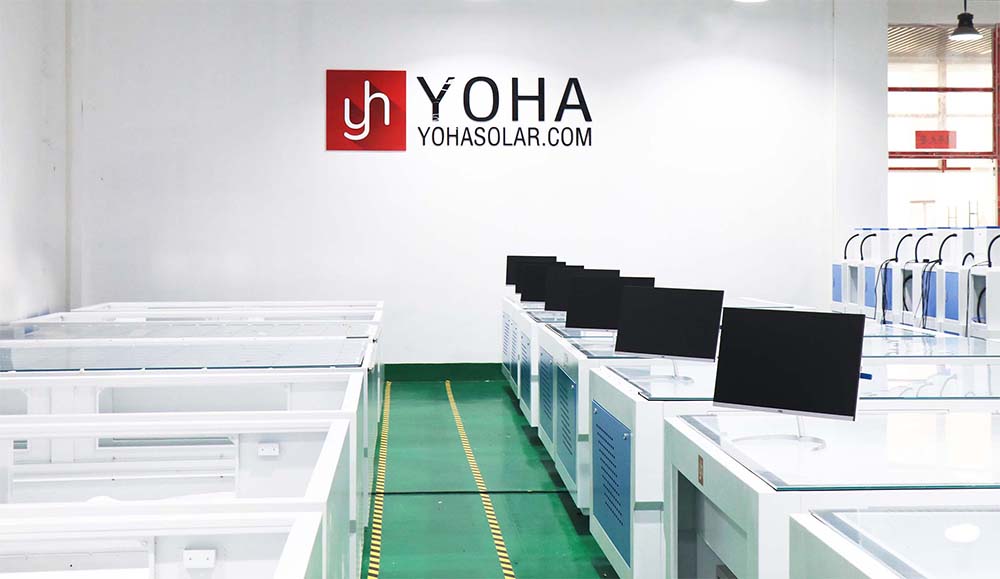Welcome to Wuhan Yoha Solar Technology Co., Ltd!
common problem
Site Map
Language:
 Chinese
Chinese
 English
English
Welcome to Wuhan Yoha Solar Technology Co., Ltd!
common problem
Site Map
Language:
 Chinese
Chinese
 English
English
In the photovoltaic industry's pursuit of higher conversion efficiency and lower levelized cost of electricity (LCOE), the subtle performance variations of each solar cell directly impact the final output power and manufacturing cost of modules. The solar cell sorter operates like a meticulously calibrated "industrial sieve," performing precise performance "check-ups" and grading on thousands of cells at millisecond speeds. It ensures the most efficient cells are accurately matched, becoming a core piece of equipment for boosting module power, optimizing resource utilization, and driving lean manufacturing.
The Significance of Sorting: From the "Bucket Effect" to "Precision Matching"
Encapsulating unsorted cells directly leads to a pronounced "bucket effect" – module power is determined by the weakest cell. The core value of the solar cell sorter lies in:
Eliminating Efficiency Loss: Grouping cells with similar efficiencies (e.g., ±0.1% or finer intervals) ensures highly consistent performance within a single module, maximizing module output power (typically increasing it by 1-3%).
Optimizing Voltage Matching: Precise binning based on open-circuit voltage (Voc) or maximum power point voltage (Vmpp) ensures voltage compatibility among modules connected in strings. This reduces system power loss due to mismatch and simplifies inverter MPPT design.
Enhancing Resource Utilization: Multi-dimensional binning based on efficiency, voltage, and appearance grade enables "high-quality for high-end, lower-quality for specific markets." Efficient cells go to premium modules, while secondary cells are rationally used in specific market segments, lowering overall costs.

Ensuring Module Reliability: Screening out cells with critical hidden defects (e.g., micro-cracks, poor sintering, low shunt resistance) prevents them from causing hot spots or accelerated degradation in modules.
Providing Data for Process Optimization: Massive sorting data (efficiency distribution, Voc/Isc fluctuations, defect rates) serves as a key indicator for monitoring the stability of upstream processes (diffusion, coating, metallization). The solar cell sorter is the "barometer" of process control.
Core Technical Architecture: Balancing Speed and Precision
Modern, high-efficiency solar cell sorters integrate precision mechanics, optoelectronics, electrical measurement, and artificial intelligence:
High-Precision Photoelectric Performance Test System:
A+ Grade Solar Simulator: Provides simulated light meeting spectral match (IEC 60904-9 Class A+), spatial uniformity (≤±2%), and temporal stability (≤±0.5%) requirements, ensuring standardized test conditions.
Ultra-Precision Four-Probe Measurement: Employs Kelvin connection (4-wire method) to eliminate cable resistance effects, accurately measuring current (Isc), voltage (Voc), etc., with current measurement accuracy typically within ±0.5%.
Rapid Scanning & Data Processing: Completes I-V curve scanning in milliseconds and calculates core parameters like efficiency (η), fill factor (FF), series resistance (Rs), and shunt resistance (Rsh) in real-time. The sorter is the cell's "data collector."
High-Speed, High-Resolution Visual Inspection System:
Multi-Angle Imaging Units: Equipped with high-resolution industrial cameras and multiple light sources (bright field, dark field, coaxial, side light) to capture surface defects from different angles: chipping, scratches, contamination, color variation, printing defects (broken fingers, misalignment, paste leakage), cracks, fingerprints, etc.
AI Recognition Engine: Deep learning-based algorithms automatically identify and classify defect types (e.g., distinguishing acceptable dirt from fatal cracks) and assign appearance grades (A, B, C grade) based on predefined criteria (size, location, quantity).
Integrated Electroluminescence (EL) Testing (Key Trend):
In-line/Near-line EL Module: Injects current into the cell to make it luminesce; a high-sensitivity infrared camera captures the image. Clearly reveals internal defects invisible to the naked eye: micro-cracks (linear/net-like), broken fingers, sintering defects, material inhomogeneity, PN junction anomalies, etc.
AI Defect Analysis: Automatically identifies defect types in EL images and assesses severity (e.g., crack length), enabling more comprehensive and reliable binning decisions when combined with electrical performance data. The sorter achieves deep quality control, from surface to core.
High-Speed, Gentle Handling & Precision Positioning Platform:
Efficient Loading/Unloading: Robots or high-speed belts/vacuum chucks enable fast, damage-free cell transfer.
Micron-Level Positioning: Ensures precise cell placement (±10μm repeatability) at test stations (electrical, visual, EL), guaranteeing accurate probe contact and clear imaging.
Multi-Lane Parallel Processing: High-end sorters feature dual or multi-lane designs, achieving throughputs exceeding 8000-12000 cells/hour.
Intelligent Data Management & Binning Execution System:
Multi-Dimensional Binning Rule Engine: Allows flexible setting of binning logic (Bin Map) based on efficiency, voltage (Voc/Vmpp), appearance grade, EL defect grade (if available), etc.
High-Speed Sorting Actuator: Pneumatic nozzles or precision robotic arms accurately blow/place cells into corresponding bins based on the results, achieving >99.9% binning accuracy.
Full Traceability: Binds cell ID (barcode/inkjet code) to all test data (electrical parameters, images, grade) and uploads it to the MES system, enabling full traceability and deep analysis.
The Sorter's Core Role in the PV Manufacturing Value Chain
The solar cell sorter is the critical link connecting cell production and module assembly; its effectiveness directly impacts the efficiency of the entire value chain:
Boosts Module Power & Product Value: Precise efficiency/voltage binning maximizes module power output, meeting demand for high-efficiency products and enhancing premium pricing capability.
Reduces Module Manufacturing Costs:
Minimizes power loss caused by cell mismatch, effectively lowering cost per watt.
Avoids rework, scrap, and warranty costs caused by low-efficiency/problem cells entering module assembly.
Optimizes cell inventory management, supplying different bin levels as needed.
Ensures Long-Term Module Reliability: Strictly screening out cells with internal defects (e.g., severe micro-cracks, EL defects) significantly reduces the risk of field failures like hot spots and accelerated power degradation.
Meets Diverse Market Demands: Flexible binning strategies enable the production of modules with different power grades and prices, precisely targeting segments from utility-scale plants to residential and BIPV markets.
Drives Continuous Cell Process Improvement: Real-time, comprehensive sorting data (efficiency standard deviation, Voc/Isc shift, specific defect occurrence rates) provides the most direct feedback for optimizing upstream processes (e.g., diffusion uniformity, coating consistency, print alignment), boosting yield and efficiency. The sorter is the "navigator" for process optimization.
Technology Evolution: Towards Higher Efficiency, Intelligence, and Flexibility
Driven by advancements in cell technology (TOPCon, HJT, BC, Perovskite), wafer thinning (<130μm), and larger formats (210mm+), solar cell sorters continuously innovate:
Pushing Limits in Precision & Speed:
Developing ultra-low current (nanoampere-level) high-precision measurement for >26% ultra-high-efficiency cells.
Enhancing EL resolution and speed to meet in-line 100% inspection needs.
Optimizing transfer and test cycles, targeting single-cell test time <0.8 seconds.
Deep AI Empowerment:
Improving AI accuracy and generalization for visual and EL defect recognition, reducing manual rechecks.
Developing big data-based binning strategy optimization models to dynamically balance maximizing module power and minimizing cost.
Exploring the use of electrical parameter signatures to predict long-term cell reliability.
Adapting to Novel Cell Technologies:
BC Cells: Developing ultra-low shadow probe cards and precise back-contact electrode positioning.
HJT/TOPCon: Optimizing test methods for low irradiance performance and low temperature coefficients.
Perovskite/Tandem: Researching spectrally adjustable test solutions and integrated stability assessment.
Thin Wafers & Large Formats: Innovating contactless/low-stress handling and positioning solutions to reduce breakage risk. Sorters must maintain technological foresight.
Multi-Function Integration & Flexible Binning:
Driving the transition of EL testing from optional to standard.
Developing flexible sorting platforms capable of handling multiple sizes and technologies simultaneously.
Enabling more complex multi-dimensional (efficiency + voltage + appearance + EL grade) combined binning.
Deep Integration into Smart Manufacturing: Interconnecting deeply with cell production equipment (PECVD, screen printers) and module MES systems for closed-loop data flow and intelligent production scheduling.
Conclusion: Precision Sorting, Intelligently Manufacturing the Future
The solar cell sorter has transcended its role as a mere binning tool, becoming an indispensable "precision brain" and "quality gate" within modern PV smart manufacturing systems. Operating at millisecond speeds, it assigns precise "performance coordinates" to every cell. Through intelligent decision-making, it drives optimal resource allocation and maximizes module power release. Leveraging data-driven insights, it continuously refines cell manufacturing processes. On the PV industry's quest for ultimate efficiency and cost, faster, more precise, and smarter solar cell sorters will continue to play a pivotal role. They lay the solid quality foundation for efficiently converting every ray of sunlight and provide the precise momentum propelling humanity's clean energy future.
keywords:TOP
18086473422
MESSAGE
